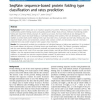Free Online Productivity Tools
i2Speak
i2Symbol
i2OCR
iTex2Img
iWeb2Print
iWeb2Shot
i2Type
iPdf2Split
iPdf2Merge
i2Bopomofo
i2Arabic
i2Style
i2Image
i2PDF
iLatex2Rtf
Sci2ools
BMCBI
2010
2010
SeqRate: sequence-based protein folding type classification and rates prediction
Background: Protein folding rate is an important property of a protein. Predicting protein folding rate is useful for understanding protein folding process and guiding protein design. Most previous methods of predicting protein folding rate require the tertiary structure of a protein as an input. And most methods do not distinguish the different kinetic nature (two-state folding or multi-state folding) of the proteins. Here we developed a method, SeqRate, to predict both protein folding kinetic type (two-state versus multi-state) and real-value folding rate using sequence length, amino acid composition, contact order, contact number, and secondary structure information predicted from only protein sequence with support vector machines. Results: We systematically studied the contributions of individual features to folding rate prediction. On a standard benchmark dataset, the accuracy of folding kinetic type classification is 80%. The Pearson correlation coefficient and the mean absolute...
| Added | 08 Dec 2010 |
| Updated | 08 Dec 2010 |
| Type | Journal |
| Year | 2010 |
| Where | BMCBI |
| Authors | Guan Ning Lin, Zheng Wang, Dong Xu, Jianlin Cheng |
Comments (0)

